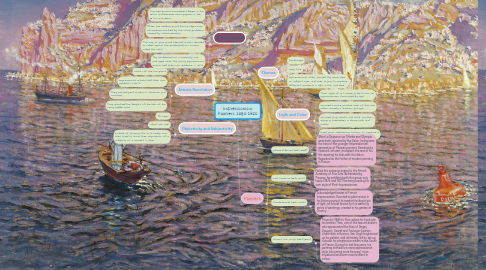
1. Artistic Revolution
1.1. Startt of the Vanguard
1.2. Impressionist artists held their own exhibition in 1874
1.3. They painted performers in theatres and circuses.
1.4. They glorified the delights of the life of the rising middle class.
2. Objectivity and Subjectivity
2.1. "As Seen"
2.2. "What you see"
2.3. Instead of showing life “as it really was” they tried to show their impression of a subjects or a moment in time.
3. Social Context
3.1. The Impressionist movement began in the 1860s and became most popular in the 1870s and 1880s.
3.2. After the mediocre and boring objectivity of Realism, marked by the social problems caused by industrialization
3.3. A group of young and talented artists decided to rebel against the established art critics, called the Salon
3.4. The established art community was outraged when the young Impressionist artists held their own exhibition in 1874.
4. Themes
4.1. Landscape
4.2. Daily Life
4.3. Impressionists often painted the same view or subject over and over trying to capture different moments in light, color, and time.
5. Ligth and Color
5.1. Their style of art came to be known as impressionism. Fascinated by light.
5.2. Showed a more positive view of the new urban society in eastern Europe.
5.3. Showed shop clerks and dock workers enjoying themselves in dance halls and cafes.
5.4. Used pure, shimmering colours to capture a moment seen at a glance.
6. Painters
6.1. Edouard Manet (1832-1883)
6.1.1. After Le Dejeuner sur l'Herbe and Olympia were both rejected by the Salon, he became the hero of the younger (Impressionist) generation of Parisian painters. Remained a classicist at heart, and spent the rest of his life repairing his links with the Salon. Regarded as the Father of modern painting in France.
6.2. Paul Cezanne (1839-1906)
6.2.1. Failed the entrance exams to the French Academy of Fine Arts. Befriended by Pissarro, he exhibited with the group only twice (1874 and 1877) before pursuing his own style of Post-Impressionism.
6.3. Claude Monet (1840-1926)
6.3.1. Acknowledged leader of French Impressionism. Devoted to plein-airism in his lifelong pursuit to master the depiction of light, he is best known for his water lily series of paintings, created in his garden at Giverny
6.4. Vincent Van Gogh (1853-1890)
6.4.1. Moved in 1886 to Paris where he lived with his brother Theo, one of the few art dealers who appreciated the likes of Degas, Gauguin, Seurat and Toulouse-Lautrec. Under their influence, Van Gogh brightened up his palette, and ultimately left to set up a studio for progressive artists in the South of France. During his last few years, his painting shifted to a more expressionist style, becoming more frenzied, more impastoed and even more brilliant in colour.

